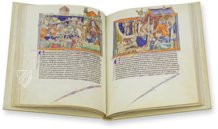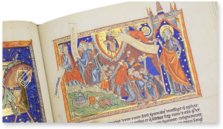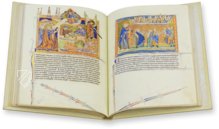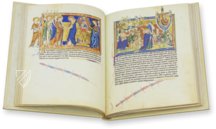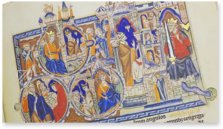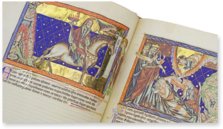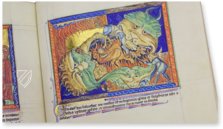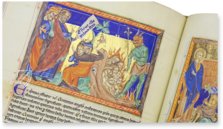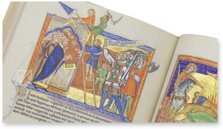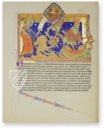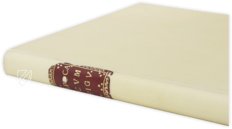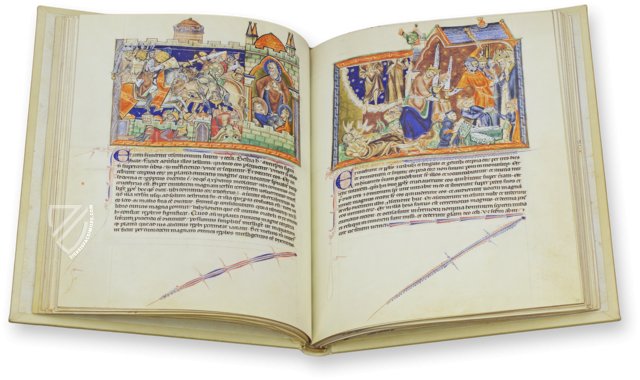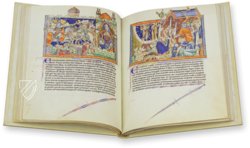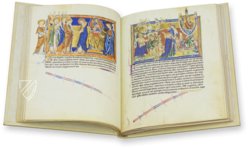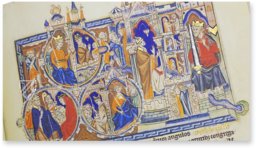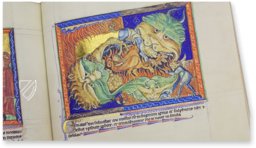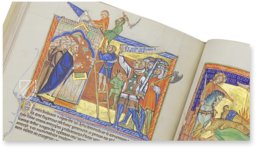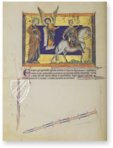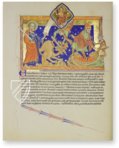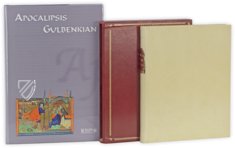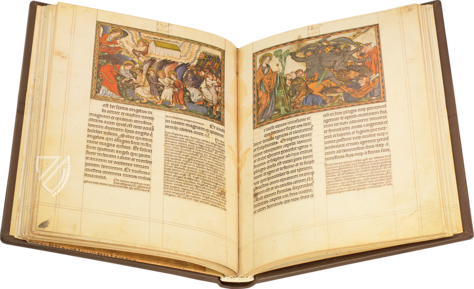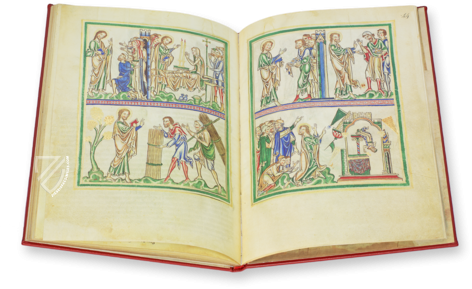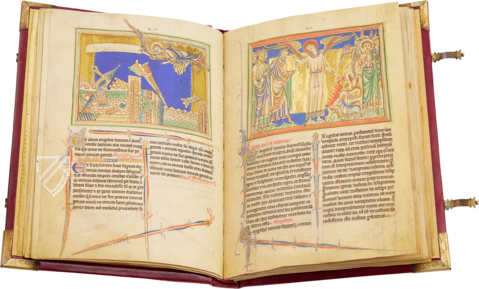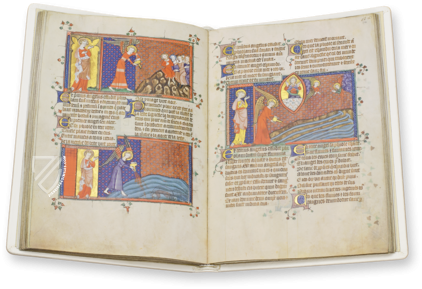Gulbenkian Apocalypse
(3,000€ - 7,000€)
The Gulbenkian Apocalypse originated in London between 1265 and 1270. The Gothic Apocalypse manuscript is adorned with high-quality miniatures in golden frames. It is one of the most beautiful manuscripts in the English Apocalypse tradition and is found today in the Gulbenkian Museum in Portugal, after which the codex is named.
Gulbenkian Apocalypse
In the 13th and 14th centuries in England, there arose a series of precious and artistically valuable illuminated manuscripts about the Book of Revelation, also known as the Apocalypse, the last book of the Bible. The Gulbenkian Apocalypse is one of the most beautiful editions of these manuscripts. The work is adorned with a great number of high quality miniatures against a gold background. It was once owned by Pope Clement IX (1600–69) and found itself in the possession of several other prominent art lovers. Today, the magnificent manuscript is housed in the Calouste Gulbenkian Museum in Lisbon, wherefrom the codex derives its name.
An Interesting Picture Cycle
The Gulbenkian Apocalypse adorns a picture cycle of 152 half-page miniatures. 78 of these illustration visually depict the history of the end of the world and the Day of Judgement. 74 additional scenes illustrate short excerpts of the rather lengthy, and beloved in 13th century English apocalypse manuscripts, Berengaudus Commentary. All of the images, in their various colors and forms, were depicted in a golden, rectangular frame. While the depictions of the biblical text emphasize the role of John as a visionary, the illustrations of the commentary stress the meaning of the sermon and of episcopal authority. The miniatures of the Gulbenkian Codex clearly eclipses the pictures from other illuminated Apocalypse manuscripts. The qualitatively valuable illuminations are in an excellent state of preservation, so that today we can still wonder at these gorgeous pictures in their full splendor.
Prominent Previous Owners
In the 17th century, the Gulbenkian Apocalypse found itself in the personal library of Pope Clement IX. The Italian art collector Cesare Battaglini, who was married to a descendant of Clement IX, is believed have purchased the manuscript in the first half of the 19th century for a hefty price. Between 1899 and 1920, the manuscript found itself in the possession of the English newspaper magnate and book collector Henry Yates Thompson. Last but not least, Calouste Gulbenkian of Portugal acquired the valuable codex for his museum in Lisbon.
Codicology
- Alternative Titles
- Apocalipsis Gulbenkian
Apokalypse Gulbenkian
Apocalisse Gulbenkian
Apocalipse Gulbenkian
Gulbenkian-Apokalypse - Size / Format
- 152 pages / 27.0 × 21.7 cm
- Origin
- United Kingdom
- Date
- 1265–1270
- Epochs
- Style
- Genre
- Language
- Script
- Gothic
- Illustrations
- 153 magnificent half-page miniatures with gold and silver leaf
- Patron
- Probably Pope Clement IX (r. 1667–1669)
- Previous Owners
- Cesare Battaglini de Rimini
Henry Yates Thompson (1838–1928)
Calouste Gulbenkian (1869–1955)
Gulbenkian Apocalypse
The First Horseman of the Apocalypse
Presented before a background combining gold leaf and a diamond patterned field of blue, the First Horseman of the Apocalypse is shown riding out attired like a late medieval nobleman. “Now I saw when the Lamb opened one of the seals; and I heard one of the four living creatures saying with a voice like thunder, ‘Come and see.’ And I looked, and behold, a white horse. He who sat on it had a bow; and a crown was given to him, and he went out conquering and to conquer.” (Rev. 6:1-2)
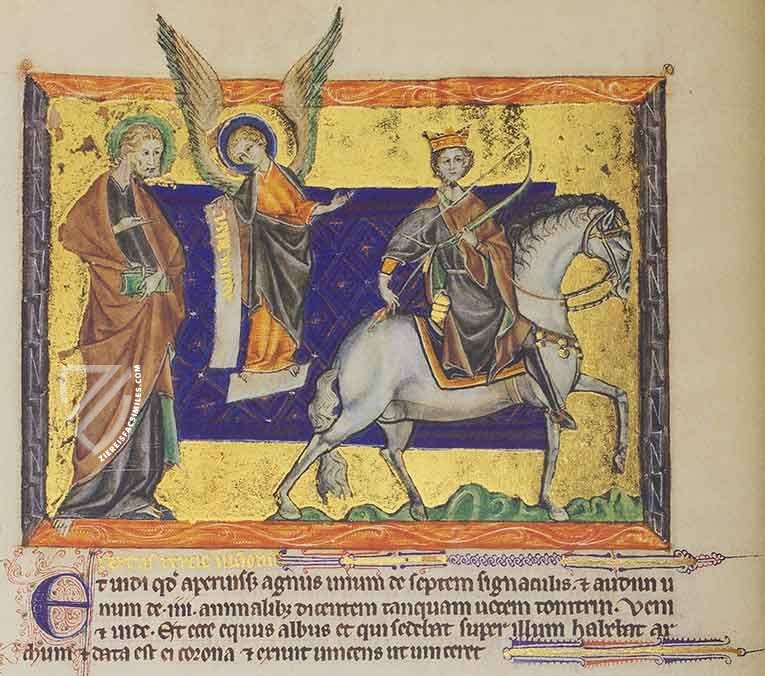
Gulbenkian Apocalypse
The Last Judgement
“And I saw the dead, small and great, standing before God, and the books were opened; and another book was opened, which is the Book of Life. And the dead were judged out of those things which were written in the books, according to their works.” (Rev. 20:12). Here we see the climatic event of the Book of Revelation divided into two busy and brightly colored registers.
In the lower register, an angel holding a sword stands guard as the dead face God’s justice, represented by a hand reaching down holding scales. Those not found in the Book of Life are cast into the lake of fire, represented here by the Hellmouth, but the faithful appear in the upper register with Christ. In this richly gilded scene, the multitudes of the Saved gather around Christ in Majesty.

#1 Apocalipsis Gulbenkian
Languages: Spanish, English
(3,000€ - 7,000€)
- Treatises / Secular Books
- Apocalypses / Beatus
- Astronomy / Astrology
- Bestiaries
- Bibles / Gospels
- Chronicles / History / Law
- Geography / Maps
- Saints' Lives
- Islam / Oriental
- Judaism / Hebrew
- Single Leaf Collections
- Leonardo da Vinci
- Literature / Poetry
- Liturgical Manuscripts
- Medicine / Botany / Alchemy
- Music
- Mythology / Prophecies
- Psalters
- Other Religious Books
- Games / Hunting
- Private Devotion Books
- Other Genres
- Afghanistan
- Armenia
- Austria
- Belgium
- Colombia
- Croatia
- Cyprus
- Czech Republic
- Denmark
- Egypt
- Ethiopia
- France
- Germany
- Greece
- Hungary
- India
- Iran
- Iraq
- Israel
- Italy
- Japan
- Lebanon
- Luxembourg
- Mexico
- Morocco
- Netherlands
- Palestine
- Peru
- Poland
- Portugal
- Russia
- Serbia
- Spain
- Sri Lanka
- Sweden
- Switzerland
- Syria
- Turkey
- Ukraine
- United Kingdom
- United States
- Uzbekistan
- Aboca Museum
- Ajuntament de Valencia
- Akademie Verlag
- Akademische Druck- u. Verlagsanstalt (ADEVA)
- Aldo Ausilio Editore - Bottega d’Erasmo
- Alecto Historical Editions
- Alkuin Verlag
- Almqvist & Wiksell
- Amilcare Pizzi
- Andreas & Andreas Verlagsbuchhandlung
- Archa 90
- Archiv Verlag
- Archivi Edizioni
- Arnold Verlag
- ARS
- Ars Magna
- ArtCodex
- AyN Ediciones
- Azimuth Editions
- Badenia Verlag
- Bärenreiter-Verlag
- Belser Verlag
- Belser Verlag / WK Wertkontor
- Benziger Verlag
- Bernardinum Wydawnictwo
- BiblioGemma
- Biblioteca Apostolica Vaticana (Vaticanstadt, Vaticanstadt)
- Bibliotheca Palatina Faksimile Verlag
- Bibliotheca Rara
- Boydell & Brewer
- Bramante Edizioni
- Bredius Genootschap
- Brepols Publishers
- British Library
- C. Weckesser
- Caixa Catalunya
- Canesi
- CAPSA, Ars Scriptoria
- Caratzas Brothers, Publishers
- Carus Verlag
- Casamassima Libri
- Chavane Verlag
- Christian Brandstätter Verlag
- Circulo Cientifico
- Club Bibliófilo Versol
- Club du Livre
- CM Editores
- Collegium Graphicum
- Collezione Apocrifa Da Vinci
- Comissão Nacional para as Comemorações dos Descobrimentos Portugueses
- Coron Verlag
- Corvina
- CTHS
- D. S. Brewer
- Damon
- De Agostini/UTET
- De Nederlandsche Boekhandel
- De Schutter
- Deuschle & Stemmle
- Deutscher Verlag für Kunstwissenschaft
- DIAMM
- Droz
- E. Schreiber Graphische Kunstanstalten
- Ediciones Boreal
- Ediciones Grial
- Ediclube
- Edições Inapa
- Edilan
- Editalia
- Edition Deuschle
- Edition Georg Popp
- Edition Leipzig
- Edition Libri Illustri
- Editiones Reales Sitios S. L.
- Éditions de l'Oiseau Lyre
- Editions Medicina Rara
- Editorial Casariego
- Editorial Mintzoa
- Editrice Antenore
- Editrice Velar
- Edizioni Edison
- Egeria, S.L.
- Eikon Editores
- Electa
- Emery Walker Limited
- Enciclopèdia Catalana
- Eos-Verlag
- Ephesus Publishing
- Ernst Battenberg
- Eugrammia Press
- Extraordinary Editions
- Fackelverlag
- Facsimila Art & Edition
- Facsimile Editions Ltd.
- Facsimilia Art & Edition Ebert KG
- Faksimile Verlag
- Feuermann Verlag
- Folger Shakespeare Library
- Franco Cosimo Panini Editore
- Friedrich Wittig Verlag
- Fundación Hullera Vasco-Leonesa
- G. Braziller
- Gabriele Mazzotta Editore
- Gebr. Mann Verlag
- Gesellschaft für graphische Industrie
- Getty Research Institute
- Giovanni Domenico de Rossi
- Giunti Editore
- Graffiti
- Grafica European Center of Fine Arts
- Guido Pressler
- Guillermo Blazquez
- Gustav Kiepenheuer
- H. N. Abrams
- Harrassowitz
- Helikon
- Hendrickson Publishers
- Henning Oppermann
- Herder Verlag
- Hes & De Graaf Publishers
- Hoepli
- Holbein-Verlag
- Hortus Deliciarum
- Houghton Library
- Hugo Schmidt Verlag
- Idion Verlag
- Il Bulino, edizioni d'arte
- ILte
- Imago
- Insel Verlag
- Instituto Nacional de Antropología e Historia
- Istituto dell'Enciclopedia Italiana - Treccani
- Istituto Ellenico di Studi Bizantini e Postbizantini
- Istituto Geografico De Agostini
- Istituto Poligrafico e Zecca dello Stato
- Italarte Art Establishments
- J. Thorbecke
- Jan Thorbecke Verlag
- Johnson Reprint Corporation
- Josef Stocker
- Josef Stocker-Schmid
- Jugoslavija
- Karl W. Hiersemann
- Kasper Straube
- Kaydeda Ediciones
- Kindler Verlag / Coron Verlag
- Kodansha International Ltd.
- Konrad Kölbl Verlag
- Kurt Wolff Verlag
- La Liberia dello Stato
- La Linea Editrice
- La Meta Editore
- Lambert Schneider
- Landeskreditbank Baden-Württemberg
- Leo S. Olschki
- Les Incunables
- Library of Congress
- Libreria Musicale Italiana
- Lichtdruck
- Lito Immagine Editore
- Lumen Artis
- Lund Humphries
- M. Moleiro Editor
- Maison des Sciences de l'homme et de la société de Poitiers
- Manuscriptum
- Martinus Nijhoff
- Maruzen-Yushodo Co. Ltd.
- MASA
- McGraw-Hill
- Militos
- Millennium Liber
- Müller & Schindler
- Nahar and Steimatzky
- National Library of Wales
- Neri Pozza
- Nova Charta
- Oceanum Verlag
- Odeon
- Orbis Mediaevalis
- Orbis Pictus
- Österreichische Staatsdruckerei
- Oxford University Press
- Pageant Books
- Parzellers Buchverlag
- Patrimonio Ediciones
- Pattloch Verlag
- PIAF
- Pieper Verlag
- Plon-Nourrit et cie
- Prestel Verlag
- Princeton University Press
- Prisma Verlag
- Priuli & Verlucca, editori
- Pro Sport Verlag
- Propyläen Verlag
- Pytheas Books
- Quaternio Verlag Luzern
- Reales Sitios
- Recht-Verlag
- Reichert Verlag
- Reichsdruckerei
- Riehn & Reusch
- Roberto Vattori Editore
- Rosenkilde and Bagger
- Roxburghe Club
- Salerno Editrice
- Sarajevo Svjetlost
- Schöck ArtPrint Kft.
- Scolar Press
- Scrinium
- Scripta Maneant
- Scriptorium
- Siloé, arte y bibliofilia
- SISMEL - Edizioni del Galluzzo
- Sociedad Mexicana de Antropología
- Société des Bibliophiles & Iconophiles de Belgique
- Soncin Publishing
- Sorli Ediciones
- Stainer and Bell
- Studer
- Styria Verlag
- Sumptibus Pragopress
- Szegedi Tudomànyegyetem
- Taberna Libraria
- Tarshish Books
- Taschen
- Tempus Libri
- Testimonio Compañía Editorial
- Thames and Hudson
- The Clear Vue Publishing Partnership Limited
- The Facsimile Codex
- The Folio Society
- The Marquess of Normanby
- The Richard III and Yorkist History Trust
- Tip.Le.Co
- TouchArt
- TREC Publishing House
- TRI Publishing Co.
- Trident Editore
- Typis Regiae Officinae Polygraphicae
- Union Verlag Berlin
- Universidad de Granada
- University of California Press
- University of Chicago Press
- Urs Graf
- Vallecchi
- Van Wijnen
- VCH, Acta Humaniora
- VDI Verlag
- VEB Deutscher Verlag für Musik
- Verlag Anton Pustet / Andreas Verlag
- Verlag Bibliophile Drucke Josef Stocker
- Verlag der Münchner Drucke
- Verlag für Regionalgeschichte
- Verlag Styria
- Vicent Garcia Editores
- W. Turnowsky
- Waanders Printers
- Wiener Mechitharisten-Congregation (Wien, Österreich)
- Wissenschaftliche Buchgesellschaft
- Wydawnictwo Dolnoslaskie
- Xuntanza Editorial
- Zakład Narodowy
- Zollikofer AG




